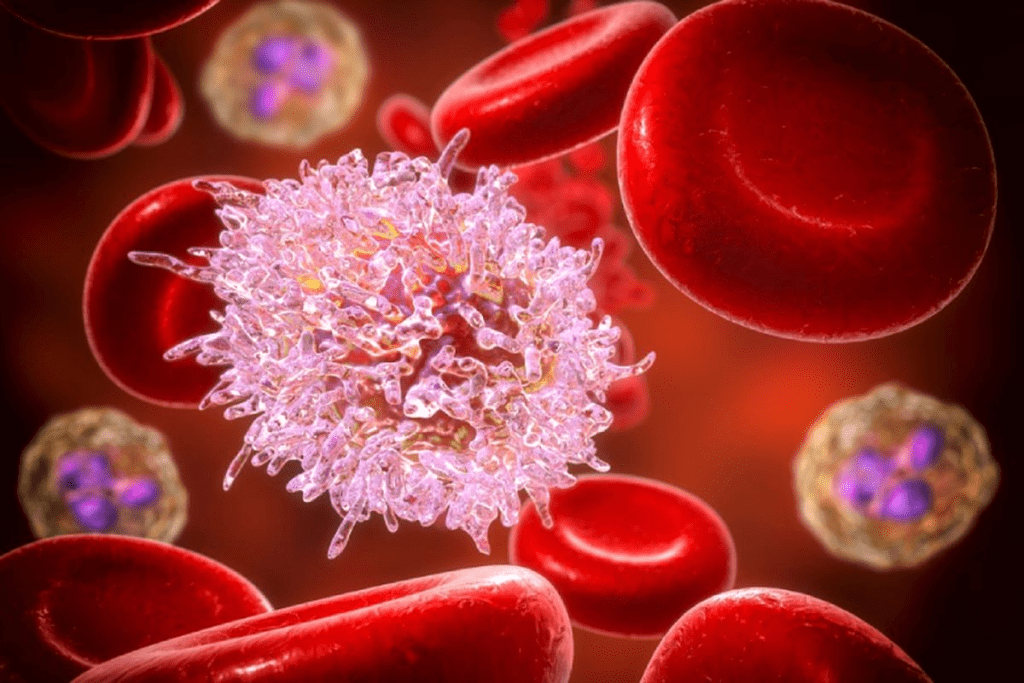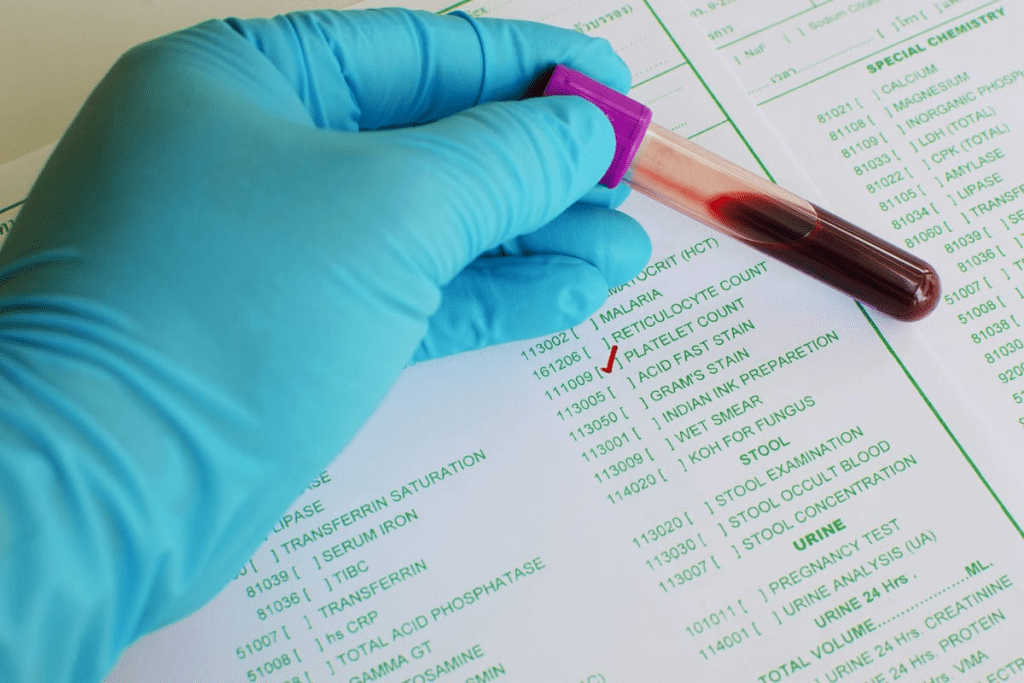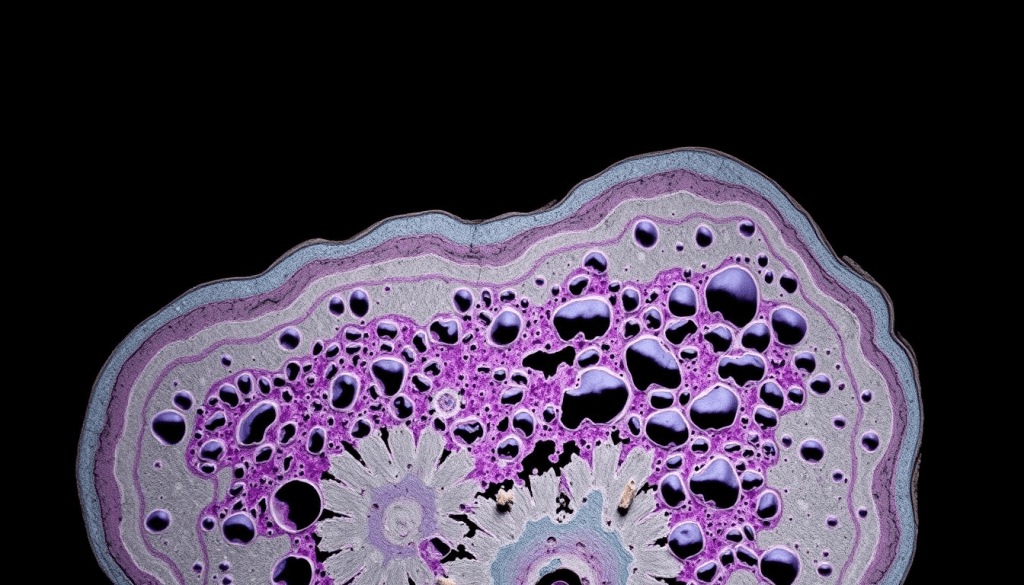Last Updated on November 13, 2025 by

Leukemia is a blood cancer that can affect platelet counts. Low platelet count, or thrombocytopenia, is a common issue for those with leukemia. Which leukemia causing thrombocytopenia is most common? Learn about this dangerous link and the crucial reasons why cancer affects platelet production.
We will look at how different leukemias can cause low platelet counts. Leukemia cells can crowd out the bone marrow, stopping it from making enough platelets.
It’s important to understand how leukemia and low platelet counts are linked. Recent studies and hospital knowledge worldwide offer key insights into this complex issue.
It’s key to know about thrombocytopenia to handle blood disorders well. This condition means you have too few platelets. It can cause bruising, bleeding, and more.
Thrombocytopenia shows up in different ways. Knowing its signs and causes is vital. We’ll look at how leukemia plays a role in it.
A low platelet count can lead to several symptoms. These include:
Platelets help blood clot. Without enough, the body can’t clot well. This causes bleeding problems.

Thrombocytopenia can come from many things. Here are some:
Knowing these causes helps in diagnosing and treating thrombocytopenia. Leukemia is a big worry because it affects the bone marrow and platelet production.
Leukemia is a complex disease that affects blood cells. It can cause problems like low platelet counts. This happens when blood cells grow abnormally, disrupting the bone marrow’s normal function.
There are different types of leukemia, mainly acute lymphoblastic leukemia (ALL) and acute myeloid leukemia (AML). Knowing these types helps us understand how leukemia can lead to low platelet counts.
Leukemia is divided into acute and chronic forms. Each type is further classified based on the affected cell lineage. The main types are:
The pathophysiology of leukemia involves the disruption of normal blood cell production. Malignant cells grow in the bone marrow. This leads to bone marrow suppression and a decrease in normal blood cells, including platelets.
Acute leukemia and low platelets are closely related. The rapid growth of leukemic cells can push out normal platelet-producing cells in the bone marrow.

Exploring leukemia’s effects on platelet counts shows the importance of understanding its pathophysiology. This knowledge is key to managing leukemia-related low platelet counts.
Understanding how leukemia causes thrombocytopenia is key to better treatment. Thrombocytopenia, or low platelet count, is a big problem for leukemia patients. It raises their risk of bleeding and affects their health outcome.
Leukemia cells can fill up the bone marrow, pushing out normal cells that make platelets. This messes up the bone marrow’s work, leading to fewer platelets. So, leukemia patients often have low platelet counts, which can get worse with chemotherapy.
The bone marrow gets crowded with leukemia cells, replacing the normal cells. This disrupts blood cell production. It can cause anemia, neutropenia, and thrombocytopenia.
Immune problems also contribute to thrombocytopenia in leukemia patients. The immune system might see platelets as enemies and destroy them. This lowers platelet counts even more.
Autoantibodies against platelet antigens mark them for destruction by the spleen. This can happen because of leukemia cells, which can mess with the immune system. It leads to autoimmune issues.
Research shows leukemia patients face a high risk of thrombocytopenia. The risk is 23% after one year and goes up to 30% after four years. Chemotherapy makes this problem worse, making it a big concern in treating leukemia.
We need to keep these facts in mind when caring for leukemia patients. This helps us give them the best care and reduce complications.
It’s important to understand how Acute Lymphoblastic Leukemia (ALL) affects platelets. ALL is a blood and bone marrow cancer that can cause low platelet counts. This is known as thrombocytopenia.
Thrombocytopenia in ALL happens because of bone marrow suppression. Leukemic cells fill the bone marrow, reducing platelet production. This affects patients with ALL.
Bone marrow infiltration by leukemic cells is a key feature of ALL. It pushes out normal cells, lowering platelet production. This leads to thrombocytopenia.
Genetic mutations, like ETV6, raise the risk of ALL. About 30% of people with these mutations will get hematologic malignancies. Most will have B-cell ALL and mild thrombocytopenia.
ETV6 mutations can cause hereditary thrombocytopenia. This increases the risk of ALL. Knowing about these genetic factors helps in early detection and treatment.
Thrombocytopenia in ALL patients is a big concern. Low platelet counts at diagnosis or during treatment mean a poorer outlook. We’ll look at how managing thrombocytopenia can improve ALL patient outcomes.
Prognostic factors in ALL include the initial platelet count. Lower counts often mean a worse prognosis. Effective management of thrombocytopenia is key to better patient outcomes.
Acute Myeloid Leukemia (AML) is a serious blood cancer that often leads to low platelet counts. This happens because AML affects the bone marrow, making it hard to produce enough platelets. We’ll look into how AML causes this problem.
AML is a diverse disease with different types, each with its own effects. The type of AML can greatly affect how low the platelet count gets. For example, Acute Promyelocytic Leukemia (APL) can cause very low platelet counts because of bleeding problems.
Knowing the type of AML is key to understanding its impact on platelet production. There are two main ways to classify AML: the French-American-British (FAB) system and the World Health Organization (WHO) system.
Understanding these classifications helps doctors predict the risk of low platelet counts in different AML types.
Some genetic changes make people more likely to get Myelodysplastic Syndromes (MDS) or AML. These changes can mess up the bone marrow’s ability to make blood cells, including platelets. For example, mutations in TP53, RUNX1, and ASXL1 genes increase the risk of MDS/AML.
People with these genetic changes often have low platelet counts. These changes can also affect how well treatment works and the patient’s outlook.
“The identification of genetic mutations in MDS/AML patients has significant implications for diagnosis, prognosis, and treatment planning.”
– A leading hematologist
The severity of low platelet counts varies among AML types. For example, APL often causes severe bleeding problems, while other types might have milder low platelet counts.
It’s important to consider each AML type’s specific traits when looking at the risk and severity of low platelet counts. This helps doctors manage the condition better and improve patient care.
Chronic leukemias can cause low platelet counts in different ways. Unlike acute leukemias, which directly block bone marrow, chronic leukemias often use the immune system to lower platelets. This can happen through various pathways.
CLL makes mature lymphocytes grow too much, filling the bone marrow. This can stop normal blood cell production, leading to low platelet counts. A study on NCBI found CLL patients often have low platelets due to their immune system attacking platelets.
Having low platelets in CLL is a bad sign. It means the disease is more advanced and can make treatment harder.
CML affects myeloid cells and can cause too many or too few platelets. In some cases, it leads to low platelet counts, which can happen during the disease’s more aggressive phases. The reasons for platelet problems in CML are complex, affecting both how many platelets there are and their quality.
Treating CML can also affect platelet counts. Keeping an eye on platelet levels is key to managing CML well.
Low platelet counts due to the immune system attacking platelets is a big problem in chronic leukemias. This happens in both CLL and CML, but more often in CLL.
Dealing with this issue involves using drugs to calm down the immune system. Sometimes, removing the spleen is needed. Knowing how it works helps doctors find better ways to treat it.
Studying leukemia and low platelet counts shows we need a detailed plan to handle these issues well.
Chemotherapy is key in fighting leukemia, but can cause thrombocytopenia. We need to understand how it affects platelet production and the risk of bleeding.
Chemotherapy targets fast-growing cells, including leukemia and bone marrow cells. This harms bone marrow, leading to fewer platelets. The impact on platelet production is a critical concern as it raises the risk of bleeding.
Several factors can increase the risk of severe thrombocytopenia in patients undergoing chemotherapy for leukemia. These include:
Understanding these risk factors is essential for tailoring treatment plans to minimize the risk of severe thrombocytopenia.
Managing chemotherapy-induced thrombocytopenia requires a multifaceted approach. We can employ several strategies to mitigate the effects of thrombocytopenia, including:
By adopting these strategies, we can reduce the risk of bleeding complications and improve patient outcomes during leukemia treatment.
Diagnosing thrombocytopenia in leukemia patients needs a detailed approach. This includes lab tests and careful watching. We will look at how to diagnose and keep track of thrombocytopenia. This ensures patients get the right care.
Laboratory tests are key in finding thrombocytopenia. A complete blood count (CBC) is often the first step. It shows platelet, white blood cell, and hemoglobin levels. Next, bone marrow aspiration and biopsy might be needed. They check if the bone marrow can make platelets and find any marrow problems.
It’s important to distinguish between thrombocytopenia caused by leukemia and that caused by treatment. Disease-related thrombocytopenia comes from leukemia in the bone marrow. Treatment-related thrombocytopenia is from chemotherapy’s side effects. Knowing the cause helps in managing the condition better.
High-risk patients, like those with acute leukemia, need close watch on their platelet counts. We suggest a regular CBC to follow platelet count changes. Also, clinical assessment for bleeding or thrombocytopenia signs is key for quick action.
With these diagnostic and monitoring methods, we can better manage thrombocytopenia in leukemia patients. This improves their outcomes and quality of life.
Managing leukemia-related low platelet counts needs a detailed plan. It must tackle the leukemia itself and the problems caused by low platelets. This includes treating the leukemia, reducing bleeding risks, and fixing bone marrow issues.
We’ve looked at different leukemia types, like ALL and AML, and how they affect platelets. Knowing how leukemia harms platelet counts is key. It helps doctors create better treatment plans.
Healthcare teams can make a big difference by using a wide range of strategies. They can manage low platelet counts and lower bleeding risks. This approach is vital for giving top-notch care to patients from around the world.
Thrombocytopenia is when you have too few platelets in your blood. It often happens in people with leukemia. Leukemia cells can fill up the bone marrow, making it hard to make platelets.
Leukemia types like ALL, AML, CLL, and CML can cause low platelet counts. This happens because leukemia cells take over the bone marrow. They also destroy platelets in the blood.
Symptoms of low platelets include easy bruising and bleeding. These signs help doctors figure out what’s causing the problem.
Leukemia cells fill up the bone marrow. This stops normal cells, like platelets, from being made. So, you end up with too few platelets.
Yes, chemotherapy can make low platelets worse. It works by slowing down platelet production.
Doctors keep an eye on platelet counts and adjust treatments. They also use medicines to help make more platelets.
Doctors use lab tests and bone marrow checks to find and track low platelets. This helps tell if it’s from the disease or the treatment.
ETV6 mutations can cause low platelets in ALL patients. Knowing this helps doctors manage the disease better.
CLL and CML can cause low platelets through the immune system. Understanding this is key to managing these diseases.
Low platelets mean a tougher fight in ALL and AML. Knowing this helps doctors plan better treatment.
To prevent bleeding, doctors treat the leukemia and manage low platelets. They also use supportive care to help.
Subscribe to our e-newsletter to stay informed about the latest innovations in the world of health and exclusive offers!